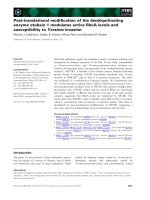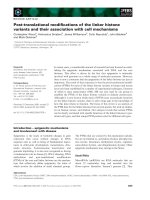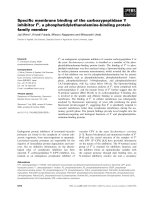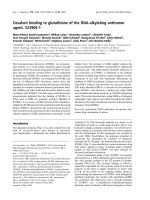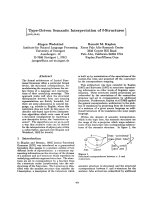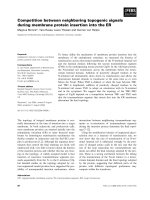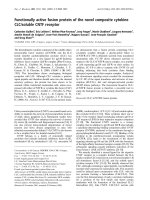báo cáo khoa học: "Metastatic eccrine porocarcinoma: report of a case and review of the literature" pptx
Bạn đang xem bản rút gọn của tài liệu. Xem và tải ngay bản đầy đủ của tài liệu tại đây (1.19 MB, 4 trang )
CAS E REP O R T Open Access
Metastatic eccrine porocarcinoma: report of a
case and review of the literature
Ugo Marone
1*
, Corrado Caracò
1
, Anna Maria Anniciello
2
, Gianluca Di Monta
1
, Maria Grazia Chiofalo
1
,
Maria Luisa Di Cecilia
1
, Nicola Mozzillo
1
Abstract
Eccrine porocarcinoma (EPC) is a rare type of skin cancer arising from the intraepidermal portion of eccrine sweat
glands or acrosyringium, representing 0.005-0. 01% of all cutaneous tumors. About 20% of EPC will recur and about
20% will metastasize to regional lymph nodes. There is a mortality rate of 67% in patients with lymph node
metastases. Although rare, the occurrence of distant metastases has been reported.
We report a case of patient with EPC of the left arm, with axillary nodal involvement and subsequent local relapse,
treated by complete lymph node dissection and electrochemotherapy (ECT).
EPC is an unusual tumor to diagnose. Neither chemotherapy nor radiation therapy has been proven to be of
clinical benefit in treating metastatic disease. Although in the current case the short follow-up period is a
limitation, we consider in the management of EPC a therapeutic approach involving surgery and ECT, because of
its aggressive pote ntial for loregional metastatic spread.
Background
Eccrine porocarcinoma (EPC) is a rare type of skin can-
cer arising from the intraepidermal portion of eccrine
sweat glands or acrosyringium, being a primary tumor or,
even more commo n, a malignant transformation of an
eccrine poroma (EP), representing 0.005-0.01% of all
cutaneous tumors [1]. In Europe, the inc idence rate was
< 0.28/100,000 [2]. It mainly occu rs in the elderly, with
equal incidence in both sexes. Approximatively less than
300 cases of EPC have been reported in medical literature
since t his disease was first described in 1963 [3-12].
About 20% of EPC will recur and about 20% will metasta-
size to regional lymph nodes [9]. There is a mortality rate
of 67% in patients with lymph node metas tases [13].
Although rare, the occurrence of distant metastases has
been reported [5].
We report a case of patient with EPC of the left arm
with axillary nodal involvement and subsequent local
relapse. The etiology, diagnosis, management and prog-
nosis of this disease are discussed, with a brief review of
the literature.
Case presentation
In February 2010 a 42-year old man presented with
palpable left axillary lymphadenopathy. Ten months
before this time point, he had been admitted to another
institution for excision biopsy of an erythematous pla-
que less than 2 cm in size on the left arm with histolo-
gical diagnosis of EPC. Then a further wide excision was
undertaken to ensure adequate clearance and histologi-
cal examination revealed no residual tumor. At our
institution a histological reexamination of the pri mary
lesion confirmed diagnosis of EPC (Figure 1) Immuno-
histochemical stains showed positive staining of the
lesional cells with cytokeratins (CK) 7+/20-, epithelial
membrane antigen (EMA) (Figure 2A-B). The tumor
depth was 3.3 mm with mitotic activity of 14 mitoses
per 10 high-power fields, and it showed lymphovascular
invasion and Pagetoid intraepidermal extension. Preo-
perative staging included imaging with ultrasounds (US),
revealing evidence of several involved nodes in the left
axilla, the largest measuring 4.1 × 2.5 cm in diameter
(Figure 3), whole body positro n emission tomography
(PET/CT), which showed uptake of the radiotracer in
the left axilla (SUV 10) without evidence of other meta-
static disease, and fine needle aspiration cytology
(FNAC), which confirmed replacemen t by EPC. The
patient underwent a complete axillary lymph node
* Correspondence:
1
Department of Surgery “Melanoma - Soft Tissues - Head & Neck - Skin
Cancers”, National Cancer Institute of Naples, Italy
Full list of author information is available at the end of the article
Marone et al. World Journal of Surgical Oncology 2011, 9:32
/>WORLD JOURNAL OF
SURGICAL ONCOLOGY
© 2011 Marone et al; licensee BioMed Central Ltd. This is an Open Access article distributed under the terms of the Creative Commons
Attribution License ( which permits unrestricted use, distribution, and reproduction in
any medium, provided the original work is properly cited.
dissection, showing 6 metastatic nodes out of 28 exam-
ined. Three months after a xillary dissection, diffuse
erythematous-violaceous plaques, measuring less than
1 cm in diameter, presented around the scar o f the pri-
mary tumor (Figure 4-A). Scraping cytology revealed
features similar to the primary tumor and were treated
Figure 1 Higher magnification revealing nests of epithelial
tumor cells with a significant degree of cytologic atypia and
mitotic activity (Hematoxylin and Eosin stain, ×60).
Figure 2 Acrosyringeal differentiation confirmed by positive
staining using antibodies to cytokeratins (CK, ×5) and to
epithelial membrane antigen (EMA, ×5) (A-B).
Figure 3 US scan - Demonstration of axillary lymph node
metastasis (4.1 × 2.5 cm).
Figure 4 Local relapse before ECT treatment and site of
primary tumor after ECT treatment (A-B).
Marone et al. World Journal of Surgical Oncology 2011, 9:32
/>Page 2 of 4
by a session of electrochemotherapy (ECT). T he proce-
dure was performed under general anesthesia. Intrave-
nous (iv) bleomycin at 15 U per m
2
of body surface
(U/m
2
) was administered by a slow infusion in a time
frame of 30 s to 1 min. Electric pulses were applied to
the tumor lesions with a Cliniporator™device (IGEA srl,
Carpi, Italy). Electrical parameters were the following: 8
pulses per run, of duration 100 μsec. and field strength
of 1000 V/cm, were delivered 8 minutes after bleomycin
injection, at the frequency of 5 kHz, by means of exter-
nal electrodes N-20-HG. After a follow-up of five
months, complete response of the local recurrence was
observed on a clinically macroscopic basis (Figure 4-B),
without any complications, well tolerated by the patient,
which also presented at this time no signs of axillary
relapse or systemic disease.
Discussion
EPC is an infrequent cutan eous neoplasm arising from
the cells of the acrosyringium with metastatic potential.
This tumor may occur de novo or developing from a pre-
existing lesion as degenerative progression, and it can
manifest clinically as a solitary lesion with non character-
istic macroscopic appearance, as an ulcerated nodule or
as a plaque, polypoid, or verrucous lesi on [ 14]. The most
common location of EPC are the lower limbs, head and
neck, trunk, vulva, breast, nail bed and upper extremities
[15]. The histological diagnosis can be done on specific
microscopic features. In the primary tumor, the malig-
nant cells arise from the intraepidermal portion of the
eccrine sweat glands and may be limited to the epidermis
or may extend into the dermis. The tumor are asym-
metric with cords and lobules o f polygonal tumor cell,
typically with a cribriform pattern. Nuclear atypia is evi-
dent, with frequent mitoses and necrosis. From the lym-
phatics, the tumor cells can invade the overlying
epidermis because of the “epidermotropic” nature of the
tumor cells (Pagetoid pattern) [16-18]. Immunohisto-
chemical studies with positive staining using antibodies
to various kinds of antigens (human CK, EMA, carcy-
noembrionic antigen, p53 protein and others) can be
done to confirm acrosyringeal different iation and to sup-
port the conclusive diagnosis [9]. The differential diagno-
sis of EPC is extensive and runs the spectrum of basal
cell carcinoma to metastatic adenocarcinoma [15]. Histo-
logic findings predictive of the aggressive clinical course
were the evidence of lymphovascular invasion, which is
associated with multiple regional cutaneous metastases,
the existence of more than 14 mitoses per field and a
tumoral depth of more than 7 mm [5]. In our case, the
tumor depth was 3.3 mm with mitotic activit y of 14
mitoses per 10 high-power fields, and it showed lympho-
vascular invasion and Pagetoid intraepidermal extension.
Both regional and distant metastases are attributed to the
tumor’ s ability to invade the dermal lymphatics. Solid
organ metastases are observed in 10% of cases, lymph
nodes metastases in 20% of cases, and local recurrence in
20% of case s [5-15]. However t he prognosis of this carci-
noma seems difficult to establish due to missed follow-up
of cases described in the literature and tumor rarity.
The optimum surgical treatment for EPC is wide surgi-
cal excision of the primary tumor with broad tumor mar-
gins, given the propensity for local recurrences, with
curative rates from 70% to 80% of cases [14-18]. Thera-
peutic lymphadenect omy should be performed in case of
lymphadenopathy, while the role of sentinel lymph node
biopsy (SLNB) for staging EPC remains unknown, and
probably may be reserved in cases of histological aggres-
siveness or intralymphatic permeation by the primary
tumor [16-20]. In our case, tumor cells were detected in
the needle aspiration of the left axillary lymph node and
an axillary lymphadenectomy was performed.
Electroporation, which can be used to introduce che-
motherapeutic drugs directly into cancer cells (electroche-
motherapy), has been shown in clinical trials to have a
high response rate in treatment of patients with primary
or metastatic skin cancers. The procedure is normally well
tolerated by patients and can be repeated [21]. It should
be considered as an excellent alternative to standard thera-
pies in treatment of locoregional recurrent EPC.
Experiences with postoperative radiotherapy are also
scarce. Its use is generally reserved for palliative care
and tumor response is both partial and inconsistent
[17-20].
No standard therapeutic protocols for metastatic EPC
exist. However, a variety of chemotherapeutics have
been used with varying degree of responsiveness. Gon-
zales-Lopez et al reported a case of a 71-year-old man
developing multiple cutaneous and regional lymph node
metastases 15 months after surgical excision of the pri-
mary tumor, treated with lymphadenectomy, radiother-
apy, and oral isotretinoin, subsequently substituted by
tegafur, with no evidence of distant metastases after a
5.6-year follow-up [16].
Conclusions
EPC is an unusual tumor to diagnose. The treatment for
the metastatic disease ha s not been standardized. Its
ear ly identification and complete excision gives the best
chance of a cure. Neither chemotherapy nor radiation
therapy has been proven to be of clinical benefit in
treating metastatic disease. Although in the current case
the short follow-up period is a limitation, we consider in
the management of EPC a therapeutic approach invol-
ving surgery and ECT, because of its aggressive potential
for loregional metastatic spread.
Marone et al. World Journal of Surgical Oncology 2011, 9:32
/>Page 3 of 4
Consent
Written informed consent was obtained from the patient
for publication of this case report and accompanying
images. A copy of the written consent is available for
review by the Editor-in-Chief of this journal.
Author details
1
Department of Surgery “Melanoma - Soft Tissues - Head & Neck - Skin
Cancers”, National Cancer Institute of Naples, Italy.
2
Department of
Pathology, National Cancer Institute of Naples , Italy.
Authors’ contributions
UM conceived the study, carried out the literature search, and draft the
manuscript; CC helped in management of the patient; AMA performed the
histological analysis and provided histological sections as figures for
manuscript; GDM helped in the preparation of the manuscript; MGC and
MLDC carried out literature review and manuscript drafting; NM made
critical revision and supervision. All authors read and approved the final
manuscript.
Competing interests
The authors declare that they have no competing interests.
Received: 13 September 2010 Accepted: 16 March 2011
Published: 16 March 2011
References
1. Wick MR, Goellner JR, Wolfe JT, Su WP: Adnexal carcinomas of the skin. I.
Eccrine carcinomas. Cancer 1985, 56:1147-1162.
2. Rare Care - Surveillance of Rare Cancers in Europe. [ecare.
eu/].
3. Pinkus H, Mehregan AH: Epidermotropic eccrine carcinoma. A case
combining features of eccrine poroma and Paget’s dermatosis. Arch
Dermatol 1963, 88:597-607.
4. Mehregan AH, Hashimoto K, Rahbari H: Eccrine adenocarcinoma. A
clinicopathologic study of 35 cases. Arch Dermatol 1983, 119:104-114.
5. Robson A, Greene J, Ansari N, Kim B, Seed PT, McKee PH, Calonje E: Eccrine
porocarcinoma (malignant eccrine poroma): a clinicopathologic study of
69 cases. Am J Surg Pathol 2001, 25:710-720.
6. McMichael AJ, Gay J: Malignant eccrine poroma in an elderly African-
American woman. Dermatol Surg 1999, 25:733-735.
7. Bleier BS, Newman JG, Quon H, Feldman MD, Kent KK, Wenstein GS:
Eccrine prorcarcinoma of the nose: case report and review of world
literature. Arch Otolaryngol Head Neck Surg 2006, 132:215-218.
8. Klenzner T, Arapakis I, Kayser G, et al: Eccrine porocarcinoma of the ear
mimicking basaloid squamous cell carcinoma. Otolaryngol Head Neck Surg
2006, 135:158-160.
9. Shiohara J, Koga H, Uhara H, Takata M, Saida T: Eccrine porocarcinoma:
clinical and pathological studies of 12 cases. J Dermatol 2007, 34:516-522.
10. Gerber PA, Schulte KW, Ruzicka T, Bruch-Gerharz D: Eccrine porocarcinoma
of the head: an important differential diagnosis in the elderly patient.
Dermatology 2008, 216:229-233.
11. Jain R, Prabhakaran VC, Huilgol SC, Gehling N, James CL, Selva D: Eccrine
porocarcinoma of the upper eyelid. Ophthal Plast Reconstr Surg 2008,
24:221-223.
12. Mahomed F, Blok J, Grayson W: The suamous variant of eccrine
porocarcinoma: a clinicopathological study of 21 cases. J Clin Pathol
2008, 61:361-365.
13. Vandeweyer E, Renorte C, Musette S, Gilles A: Eccrine porocarcinoma: a
case report. Acta Chir Belg 2006, 106:121-123.
14. Shaw M, McKee PH, Lowe D, Black MM: Malignant eccrine poroma: a
study of twenty-sweven cases. Br J Dermatol 1982, 107:675-680.
15. Brown CW Jr, Dy LC: Eccrine porocarcinoma. Dermatol Ther
2008, 433-438.
16. Gonzales-Lopez MA, Vasquez-Lopez F, Soler T, Gomez-Diez S, Garzia YH,
Manjon JA, Lopez-Escobar M, Perez-Oliva N: Metastatic Eccrine
Porocarcinoma: a 5.6 year follow-up study of a patient treated with a
combined therapeutic protocol. Dermatol Surg 2003, 29:1227-1232.
17. De Giorgi V, Sestini S, Massi D, Papi F, Lotti T: Eccrine Porocarcinomna: a
rare but sometimes fatal malignant neoplasm. Dermatol Surg 2007,
33:374-377.
18. Luz Mde A, Ogata DC, Montenegro MF, Biasi LJ, Ribeiro LC: Eccrine poro
carcinoma (malignant eccrine poroma): a series of eight challenging
cases. Clinics (Sao Paulo) 2010, 65:739-742.
19. Goel R, Contos MJ, Wallace ML: Widespread metastatic eccrine
porocarcinoma. J Am Acad Dermatol 2003, 49:252-254.
20. Nouri K, Rivas MP, Pedroso F, Bhatia R, Civantos F: Sentinel lymph node
biopsy for high-risk cutaneous squamous cell carcinomas of the head
and neck. Arch Dermatol 2004, 140:1284.
21. Testori A, Tosti G, Martinoli C, Spadola G, Cataldo F, Verrecchia F, Baldini F,
Mosconi M, Soteldo J, Tedeschi I, Passoni C, Pari C, Di Pietro A, Ferrucci PF:
Electrochemotherapy for cutaneous and subcutaneous tumor lesions: a
novel therapeutic approach. Dermatol Ther 2010, 23:651-661.
doi:10.1186/1477-7819-9-32
Cite this article as: Marone et al.: Metastatic eccrine porocarcinoma:
report of a case and review of the literature. World Journal of Surgical
Oncology 2011 9:32.
Submit your next manuscript to BioMed Central
and take full advantage of:
• Convenient online submission
• Thorough peer review
• No space constraints or color figure charges
• Immediate publication on acceptance
• Inclusion in PubMed, CAS, Scopus and Google Scholar
• Research which is freely available for redistribution
Submit your manuscript at
www.biomedcentral.com/submit
Marone et al. World Journal of Surgical Oncology 2011, 9:32
/>Page 4 of 4
